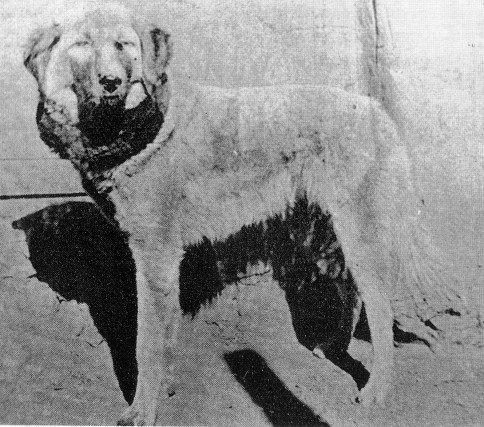
From: “ Dogs In Britain, A Description of All native Breeds and Most Foreign Breeds in Britain” by Clifford LB Hubbard, 1948
The Chow Chow too was for centuries well fattened with rice and eaten as part of the staple diet although as time advanced its meat became a delicacy rather than a commonplace. Until about fifty years ago, however, eating-houses catering for artisans and trades-people were daily serving up dishes of dog meat, and quite recently [to 1948] the flesh of dogs and cats was openly on sale in the Chinese butcher shops, despite the prohibition on such sales made about the year 1915. In Canton the custom is dying less gradually where the Buddhist priests frown on such an unwarranted end to the faithful servants of man.
The Phillipinos, particularly the inhabitants of the largest island of the group, Luzon, frequently eat the flesh of the native breed of dog. This breed is also fattened with rice and roast with a stuffing of local roots and spices. The American authorities do not encourage the custom, but it nevertheless survives in the mountainous hinterland.

Many breeds of dogs indigenous to the Central African regions are eaten by natives, especially those in the areas east of the Congo and North-east to the Nile, although not all the Nilotic races regard the dog as being edible. Such breeds as the Niam Niam and Manboutou are bred principally for food and comparatively few are retained for hunting and the guarding of villages.
It is rather remarkable that edible dogs have, so far as the author can trace, been small or medium in size; the quality of the meat rather than the quantity seems to have been the determining point. Not one really large breed has been habitually regarded as an edible dog, and in fact most of the well-appreciated dog dishes appear to have been from the midget varieties. One such breed was the Teechichi, the fourteenth-century representative of the modern Chihuahua of Mexico. The Teechichi was an unusually small variety of lap-dog which was chiefly bred for use in various sacrificial rites, and ordinarily the sacred dish of the Aztec high priests.
Dogs have been eaten not only habitually by primitive tribesmen but also on many occasions by white men, particularly by explorers who, finding their stock of food exhausted, have had recourse to cook animals other than those usually eaten. Most of the old references to the flesh of dog meat have stated that to the white man the taste was very much like veal: the author has eaten domestic dog roasted in the usual way and can confirm that the flavour is indeed remarkably like veal and quite pleasing to the palate. Boiled dog hams are also tasty; these are popular in Inner Mongolia and are marketed in thousands.
The Chihuahua is descended from the Aztec Sacred Dog and was once a sacred dish of the high priests (see Edible Dogs and Sacred Dogs). The Aztecs (tribal name for the last Nahuati irnigrants into the Mexican valleys) first arrived in Mexico in about 1250 although they did not settle until 1325 when they founded the two original communities of Tenochtitlan and Tlatelulco; in both of these settlements sacred dogs were bred, which were castrated and fattened with rice. Even after the Spanish conquest these Aztec Sacred Dogs or Teechichi were mainly bred for food, though a few were kept as pets, foot warmers and pillows.
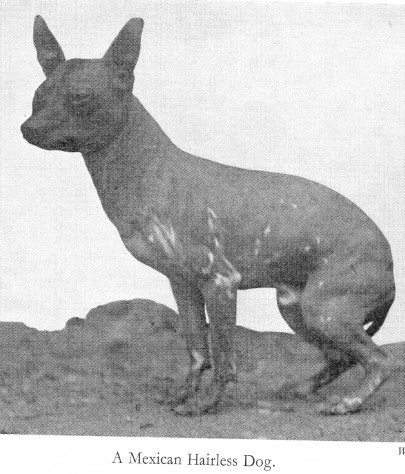
[...]Mexican Hairless Dog, which is recognised by the American Kennel Club and classified as a Toy Dog. This type is supported in a small way and exhibited from time to time. The earliest and most typical specimens to have been imported into Britain were those owned by Mr. H. C. Brooke who was never really happy unless he had a full kennel of some or other exotic breed. Its colour is usually pink, light slate blue, dark slate, black, or mottled. In build it is generally light in bone and roach-backed, something like an Italian Greyhound. Height is about 11 inches and weight about 10 pounds. At one time it was used for food.
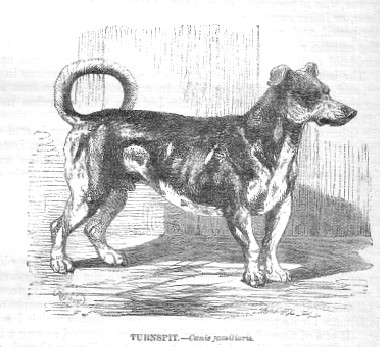 |
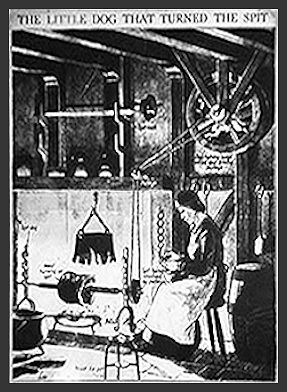 |
 |
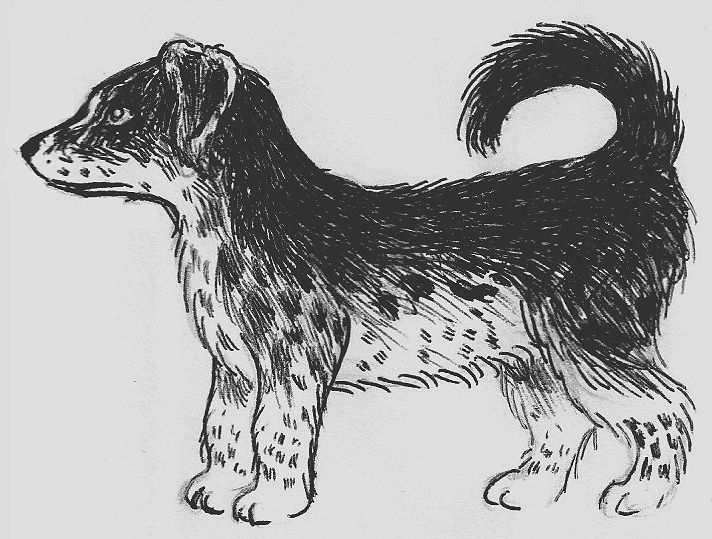 |
The Turnspit Dog, also called Canis vertigus (a Latin classification meaning “dizzy dog”), vernepator cur, kitchen dog and turn-tyke, was a necessity in kitchens from the 1500s until the mid-1800s. Meat was roasted on a spit over an open fire. This could take around three hours and turning the spit was a hot and arduous task. Initially it was done by a crank boy, but later, the Turnspit dog became indispensable. John Caius, author of “Of Englishe Dogges” (1576), wrote in the fourth Section of this discourse “Dogs of the coarser sort are the shepherds dog, the mastiff or Bandog. These two are the principal sorts. [. . .] In Latin Aquarius, in English “Water drawer” - these are of the greater and heavier sort drawing water out of wells and deep pits, by a wheel which they turn round about by the moving of their burdensome bodies. This kind of dog is likewise called Turnespit, in Latine Verunersator. There are known, under the curs of the coarsest kind, one that is excellent in kitchen service. For when any meat is to be roasted they go into a wheel which they turn round and round with the weight of their bodies. They so diligently look to their business that no drudge nor scullion can do the feat more cunningly.”
Shakespeare mentions them in his play “Comedy of Errors” when he described someone as being a curtailed dog fit only to run in a wheel. Curtailed means “docked,” a trait that distinguished commoners’ working dogs from those owned by their social betters (and Shakespeare was playing on words because cur meant a mongrel dog).
By the 1600s, many large households had such dogs, as did inns and hostelries. The dogs were heavy-set (muscular and/or cobby) and came in a variety of colours, often with odd colour eyes – one iris black and the other white - a trait of merle-patterned dogs. They had to be compact enough to fit into the wooden tread-wheel that drove the spit’s turning mechanism. Bingley’s Memoirs of British Quadrupeds (1809) stated “The Turnspits are remarkable for their great length of body and short and usually crooked legs. Their colour is generally a dusky grey spotted with black or entirely black with the under parts whitish.” This describes the merle pattern.
According to "Historic Houses in Bath, and their Associations" by R.E. Peach (1883): In 1813, his Royal Highness the DUKE OF CAMBRIDGE arrived at the York House, and received from the authorities the usual compliments, together with the Freedom of the city in a gold box; and during the same month the COUNT DE PROVENCE, afterwards Louis XVIII., also came hither and remained some time at 34, Pulteney Street. Mainwaring says of these visits during the dull month: — "As much at leisure as a Bath turnspit in the month of July." At this period it was computed that there were in Bath not less than 3,000 of these duck-legged animals, which in the [high] season were the valuable allies of the cooks."
Although any strong and compact dog could do the task, a specialised breed was developed, probably from Corgis and various terriers. They were heavy enough to be able to turn a 30 pound wheel and they were bred with the compulsion to keep moving. In France the Turnspit was described as “Basset a jambs torses” (short legged dog with twisted legs) and depicted as a short-legged dog with a long heavy body akin to the modern Basset Griffon Vendeen – a hairy, broad-chested, short -legged breed whose front legs turn slightly outward. Developing a Turnspit breed was no different from developing a herding or guarding breed – it was a dog for a job.
Luckier Turnspit dogs worked shifts, two dogs alternating every couple of hours. They didn’t get water during their shift and were subjected to the heat of the fire as well as the smell of cooking meat. Tired or lazy dogs were hurried along by a live coal put into the wheel behind them –if they didn’t keep moving the coal burnt their hind legs so they were constantly running away from it. There were some drawbacks. An 18th-century turnspit owner complained of the dog “doing his business all over the kitchen.” It’s not hard to imagine the result if the dogs peed or pooped while running (as sled dogs do). On Sundays, the Turnspit dog often had a respite, perhaps accompanying the family to church to do duty as a foot warmer. According to one anecdote, the Bishop of Gloucester’s sermon contained the line “It was then that Ezekial saw the wheel” at which point the dogs ran off, associating the word with their drudgery!
The work was hard, hot and boring. Charles G Harper wrote in his “The Old Inns of England” (1906): “The poor animal [. . .] went about his employment like a caged mouse or squirrel with his recreation wheel [. . .] revolved in a treadwheel, which in this instance was connected with apparatus for turning the joints roasting at the fire and formed not so much recreation as extremely hard work.” A Mr Wigstead, in describing a pub in Newcastle, wrote “Great care must be taken that this animal does not observe the cook approach the larder. If he does, he immediately hides himself for the remainder of the day.”
Turnspit dogs were also used to drive fruit presses, cider mills, butter churns, water pumps and grain mills, although a patented dog-powered sewing machine didn’t make it beyond the concept stage. Caius mentioned their use for drawing water from wells. Queen Victoria kept three Turnspits as household pets, rather than working dogs. In 1750 there were turnspits everywhere, but by 1850 they had become scarce, and by 1900 they had disappeared in all but the poorest households as people switched to ovens and ranges and new cooking methods.
Turnspit dogs didn’t achieve the same popularity in the United States. Hannah Penn, the wife of William Penn, founder of Pennsylvania wrote to England requesting that the dogwheel for her turnspits be sent. Benjamin Franklin’s Pennsylvania Gazette carried advertisements for Turnspit dogs and dog-wheels for sale. A turnspit was active in the kitchen of the Statehouse Inn in Philadelphia and in 1745 the owner of that inn advertised Turnspit dogs for sale, which showed he was breeding them. The treatment of Turnspit Dogs in an 1850s Manhattan hotel so angered activist Henry Berg that it was part of his inspiration for founding the ASPCA. He cited their treatment as tantamount to slavery and abhorred their lack of access to water while working, and use of hot coals to goad them if they slackened pace. Luckily for the dogs, automation, kitchen ranges and gas cookers freed them from labour, but also brought about the breed’s extinction.
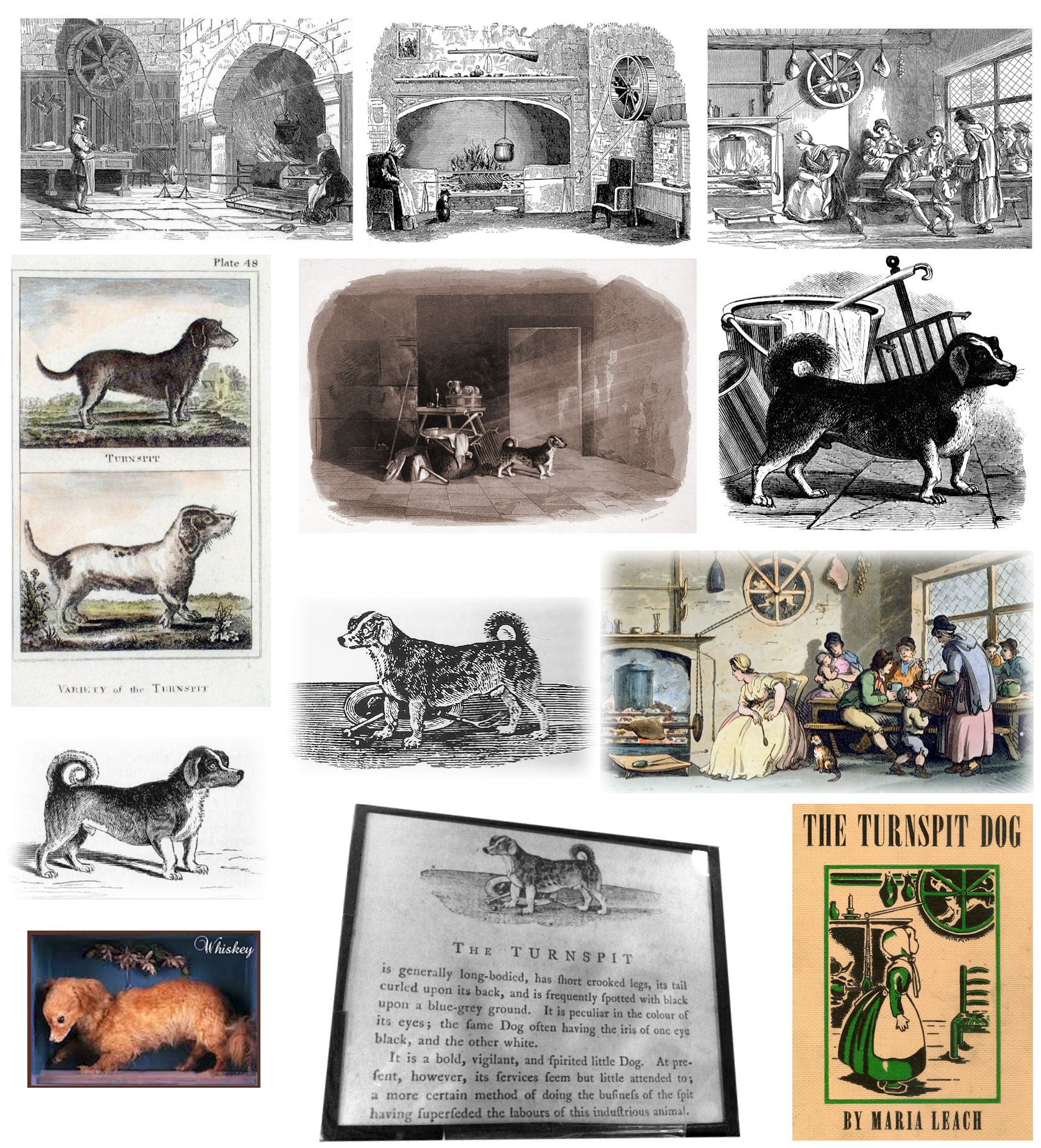
THE TURNSPIT - Chambers Book of Days, 1869: April 8th (Robert Chambers)
A few months ago the writer happened to be at an auction of what are technically termed fixtures; in this instance, the last moveable furnishings of an ancient country-house, about to be pulled down to make room for a railway station. Amongst the many lots arranged for sale, was a large wooden wheel enclosed in a kind of circular box, which gave rise to many speculations respecting the use it had been put to. At last, an old man, the blacksmith of the neighbouring village, made his appearance, and solved the puzzle, by stating that it was a dog-wheel,'—a machine used to turn a spit by the labour of a dog; a very common practice down to a not distant period, though now scarcely within the memory of living men. Besides the blacksmith, the writer has met with only one other person who can remember seeing a turnspit dog employed in its peculiar vocation; but no better authority can be cited than that of Mr. Jesse, the well-known writer on rural subjects, who thus relates his experiences:
Turnspit Dogs
“How well do I recollect in the days of my youth watching the operations of a turnspit at the house of a worthy old Welsh clergyman in Worcestershire, who taught me to read! He was a good man, wore a bushy wig, black worsted stockings, and large plated buckles in his shoes. As he had several boarders as well as day scholars, his two turnspits had plenty to do. They were long-bodied, crook-legged, and ugly dogs, with a suspicious, unhappy look about them, as if they were weary of the task they had to do, and expected every moment to be seized upon to perform it. Cooks in those days, as they are said to be at present, were very cross; and if the poor animal, wearied with having a larger joint than usual to turn, stopped for a moment, the voice of the cook might be heard rating him in no very gentle terms. When we consider that a large solid piece of beef would take at least three hours before it was properly roasted, we may form some idea of the task a dog had to perform in turning a wheel during that time. A pointer has pleasure in finding game, the terrier worries rats with eagerness and delight, and the bull-dog even attacks bulls with the greatest energy, while the poor turnspit performs his task with compulsion, like a culprit on a tread-wheel, subject to scolding or beating if he stops a moment to rest his weary limbs, and is then kicked about the kitchen when the task is over.”
The services of the turnspit date from an early period. Doctor Caius, founder of the college at Cambridge which bears his name, and the first English writer on dogs, says:
“There is comprehended under the curs of the coarsest kind a certain dog in kitchen service excellent. For when any meat is to be roasted, they go into a wheel, which they turning about with the weight of their bodies, so diligently look to their business, that no drudge nor scullion can do the feat more cunningly, whom the popular sort hereupon term turnspits.”
The annexed illustration, taken from Remarks on a Tour to North and South Wales, published in 1800, clearly exhibits how the dog was enabled to perform his curious and uncongenial task. The letterpress in reference to it says:
“Newcastle, near Carmarthen, is a pleasant village; at a decent inn here a dog is employed as turnspit; great care is taken that this animal does not observe the cook approach the larder; if he does, he immediately hides himself for the remainder of the day, and the guest must be contented with more humble fare than intended.”
One dog being insufficient to do all the roasting for a large establishment, two or more were kept, working alternately; and each animal well knowing and noting its regular turn of duty, great difficulty was experienced in compelling it to work out of the recognised system of rotation. Buffon relates that two turnspits were employed in the kitchen of the Duc de Lianfort at Paris, taking their turns every other day to go into the wheel. One of them, in a fit of laziness, hid itself on a day that it should have worked, so the other was forced to go into the wheel instead. When the meat was roasted, the one that had been compelled to work out of its turn began to bark and wag its tail till it induced the scullions to follow it; then leading them to a garret, and dislodging the skulker from beneath a bed, it attacked and killed its too lazy fellow-worker.
A somewhat similar circumstance occurred at the Jesuits' College of La Flèche. One day, the cook, having prepared the meat for roasting, looked for the dog whose turn it was to work the wheel for that day; but not being able to find it, he attempted to employ the one whose turn it was to be off duty. The dog resisted, bit the cook, and ran away. The man, with whom the dog was a particular favourite, was much astonished at its ferocity; and the wound being severe and bleeding profusely, he went to the surgeon of the College to have it dressed. In the meantime the dog ran into the garden, found the one whose turn it was to work the spit for that day, and drove it into the kitchen; where the deserter, seeing no opportunity of shirking its day's labour, went into the wheel of its own accord, and began to work.
Turnspits frequently figure in the old collections of anecdotes. For instance, it is said that the captain of a ship of war, stationed in the port of Bristol for its protection in the last century, found that, on account of some political bias, the inhabitants did not receive him with their accustomed hospitality. So, to punish them, he sent his men ashore one night, with orders to steal all the turnspit dogs they could lay their hands upon. The dogs being conveyed on board the ship, and snugly stowed away in the hold, consternation reigned in the kitchens and dining-rooms of the Bristol merchants; and roast meat rose to a premium during the few days the dogs were confined in their floating prison. The release of the turnspits was duly celebrated by many dinners to the captain and his officers.
In an exceeding rare collection of poems, entitled Norfolk Drollery, there are the following lines
Upon a dog called Fuddle, turnspit at the Popinjay, in Norwich.
“Fuddle, why so? Some fuddle-cap sure came
Into the room, and gave him his own name;
How should he catch a fox? he'll turn his back
Upon tobacco, beer, French wine, or sack.
A hone his jewel is; and he does scorn,
With AEsop's cock, to wish a barley-corn.
There's not a soberer dog, I know, in Norwich,
What would ye have him drunk with porridge?
This I confess, he goes around, around,
A hundred times, and never touches ground;
And in the middle circle of the air
He draws a circle like a conjuror.
With eagerness he still does forward tend,
Like Sisyphus, whose journey has no end.
He is the soul (if wood has such a thing?)
And living posy of a wooden ring.
He is advanced above his fellows, yet
He does not for it the least envy get.
He does above the Isle of Dogs commence,
And wheels the inferior spit by influence.
This, though, befalls his more laborious lot,
He is the Dog-star, and his days are hot.
Yet with this comfort there's no fear of burning,
'Cause all the while the industrious wretch is turning.
Then no more Fuddle say; give him no spurns,
But wreak your spleen on one that never turns,
And call him, if a proper name he lack,
A four-foot hustler, or a living Jack.”
The poets not unfrequently used the poor turnspit as an illustration or simile. Thus Pitt, in his Art of Preaching, alluding to an orator who speaks much, but little to the purpose, says:
“His arguments in silly circles run,
Still round and round, and end where they begun.
So the poor turnspit, as the wheel runs round,
The more he gains, the more he loses ground.”
A curious political satire, published in 1705, and entitled The Dog in the Wheel, shews, under the figure of a turnspit dog, how a noisy demagogue can become a very quiet placeman. The poem commences thus:
“Once in a certain family,
Where idleness was disesteemed;
For ancient hospitality,
Great plenty and frugality,
'Bove others famous deemed.
No useless thing was kept for show,
Unless a paroquet or so;
Some poor relation in an age,
The chaplain, or my lady's page:
All creatures else about the house
Were put to some convenient use.
Nay, ev'n the cook had learned the knack
With cur to save the charge of jack;
So trained 'em to her purpose fit,
And made them earn each bit they ate.
Her ready servants knew the wheel,
Or stood in awe of whip and bell;
Each had its task, and did it well.”
The poem as it proceeds describes the dogs in office lying by the kitchen fire, and discussing some savoury bones, the well-earned rewards of the day's exertions. The demagogic cur, entering, calls them mean, paltry wretches, to submit to such shameful servitude; unpatriotic vermin to chew the bitter bones of tyranny. For his part, he would rather starve a thousand times over than do so. Woe be to the tyrannic hand that would attempt to make him a slave, while he had teeth to defend his lawful liberty—and so forth. At this instant, however, the cook happens to enter:
“And seeing him (the demagogue) among the rest,
She called him very gently to her,
And stroked the smooth, submissive cur:
Who soon was hushed, forgot to rail,
He licked his lips, and wagged his tail,
Was overjoyed he should prevail
Such favour to obtain.
Among the rest he went to play,
Was put into the wheel next day,
He turned and ate as well as they,
And never speeched again.”

From: “The Illustrated natural History (Mammalia)” The Rev J G Wood (1853, 1874)
Just as the invention of the spinning-jenny abolished the use of distaff and wheel, which were formerly the occupants of every well-ordained English cottage, so the invention of automaton roasting-jacks has destroyed the occupation of theTURNSPIT DOG, and by degrees has almost annihilated its very existence. Here and there a solitary Turnspit may be seen, just as a spinning-wheel or a distaff may be seen in a few isolated cottages; but both the Dog and the implement are exceptions to the general rule, and are only worthy of notice as being curious relics of a bygone time.
In former days, and even within the remembrance of the present generation, the task of roasting a joint of meat or a fowl was a comparatively serious one, and required the constant attendance of the cook, in order to prevent the meat from being spoiled by the unequal action of the fire. The smoke-jack, as it was rather improperly termed - inasmuch as it was turned, not by the smoke, but by the heated air that rushed up the chimney - was a great improvement, because the spit revolved at a rate that corresponded with the heat of the fire.
So complicated an apparatus, however, could not be applied to all chimneys, or in all localities, and therefore the services of the Turnspit Dog were brought into requisition. At one extremity of the spit was fastened a large circular box, or hollow wheel, something like the wire wheels which are so often appended to squirrel-cages; and in this wheel the Dog was accustomed to perform its daily task, by keeping it continually working. As the labour would be too great for a single Dog, it was usual to keep at least two animals for the purpose, and to make them relieve each other at regular intervals. The dogs were quite able to appreciate the lapse of time, and, if not relieved from their toils at the proper hour, would leap out of the wheel without orders, and force their companions to take their place, and complete their portion of the daily toil.
There are one or two varieties of this Dog, but the true Turnspit breed is now nearly extinct in this country. On the Continent, the spits are still turned by canine labour in localities; but the owners of spit and Dog are not particular about the genealogy of the animal, and press into their service any kind of Dog, provided that it is adequately small and sufficiently amenable to authority.
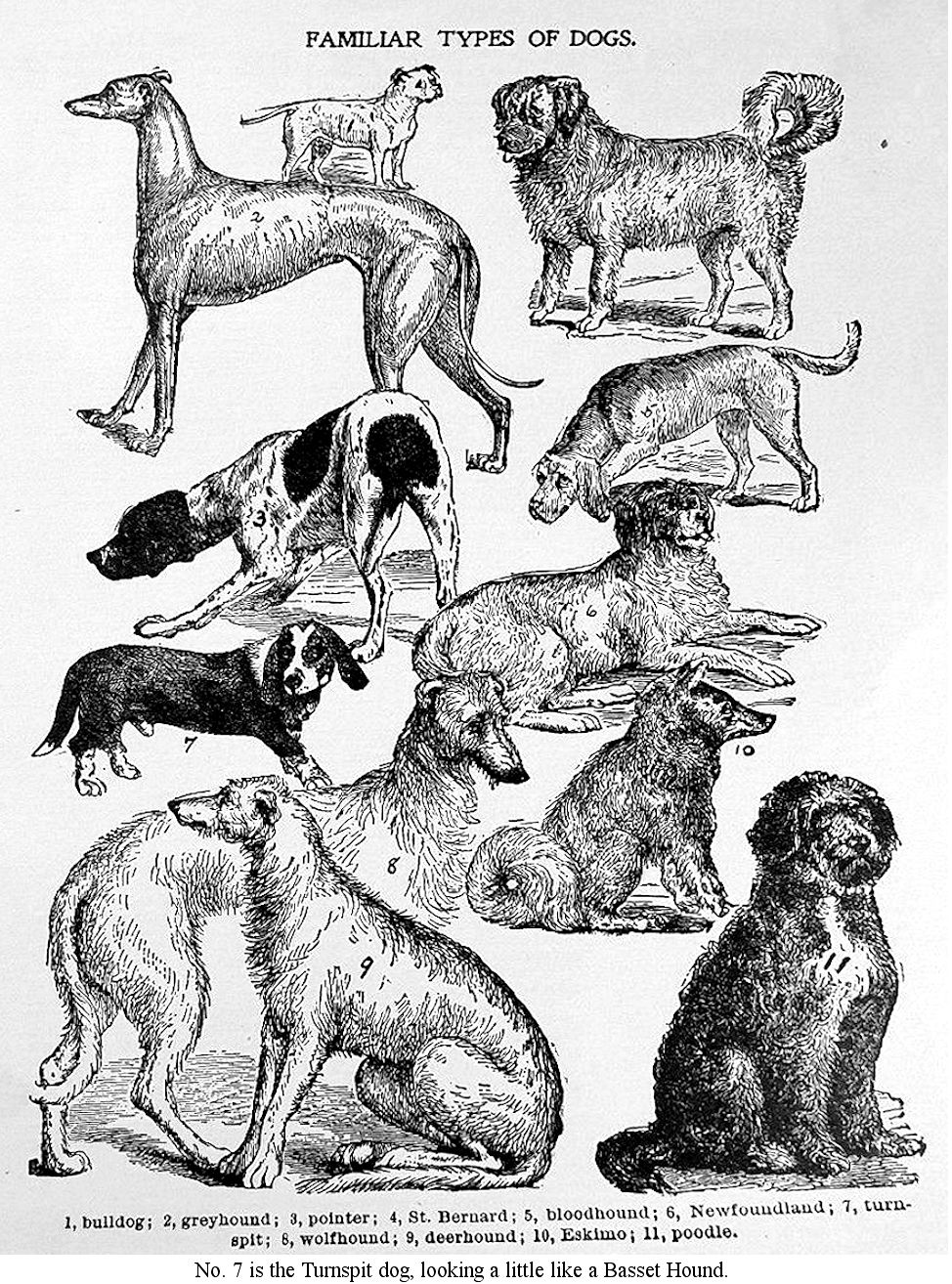
From "The Harmsworth Natural History" (R Lydekker) in 1910:
With the cessation of its monotonous occupation has come about the practical extinction of the old English turnspit, which was a long-bodied, short-limbed dog, with the fore feet everted, closely allied to the dachshund, but relatively taller, with a longer head and nose, straighter forehead, less bent fore limbs, and a longer and- thinner tail; the ears being small and placed relatively far back. In colour the turnspit was black and tan. These dogs performed their task in a kind of wire barrel, somewhat like that in a squirrel cage; in England two of them were generally kept, which worked turn and turn about.
The Rampur Hound is also known as the Rampur Greyhound and North-Indian Greyhound and was bred to hunt jackals. They were bred from the powerful but ferocious Tazi (an Afghan breed) and the English Greyhound that was too delicate for the Indian climate. It inherited the looks and courage of the Tazi, and the speed and agility of the English Greyhound. Its head is broader and coarser than the English Greyhound. A few exist in the USA, but the Rampurs were so extensively interbred with English Greyhounds, the type shown in the 1800s photo has been lost, and the modern breed appears as a robust English Greyhound.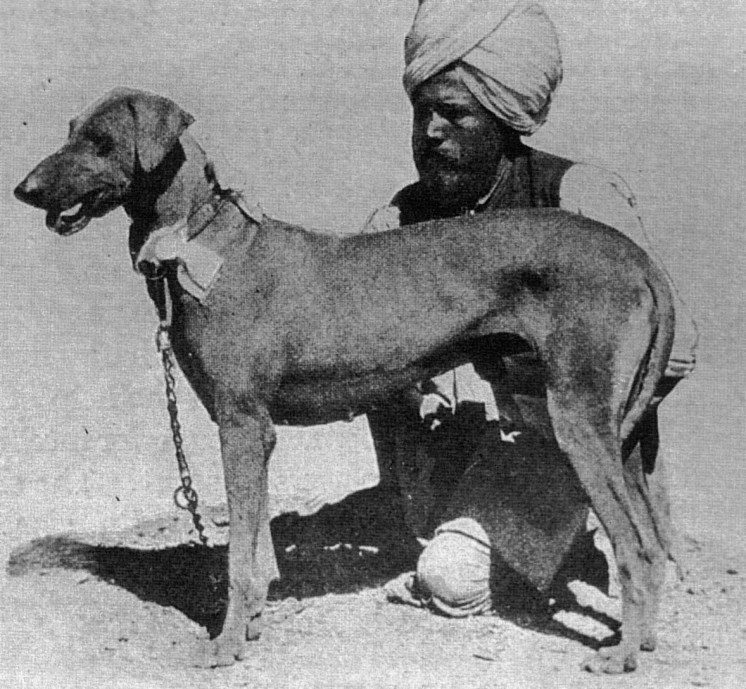
A dog of rural Tibet. About 23 inches tall and bred in fawn or grey, this was used for holding game, such as wild sheep, at bay and barking until the hunter came to make the kill. Usually the dog was taken within sight of the game before being unleashed for the chase. The training of Tibetan Hunting Dogs was harsh. Puppies were leashed to their mother when she went after game and were dragged along after her. Not all survived, but those that did were supposedly fierce and keen. It also meant only the fitter and faster youngsters survived, keeping the gene pool healthy. Their temperament makes them unsuitable as pets - as one writer of the 1930s put it, they were "tiresome in attcking strangers."
